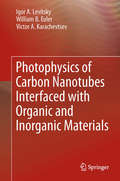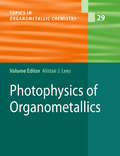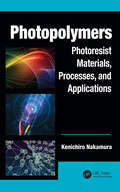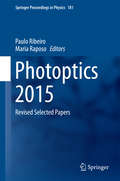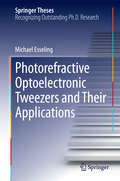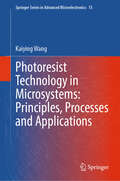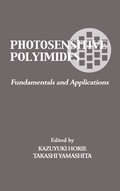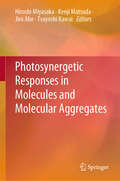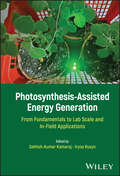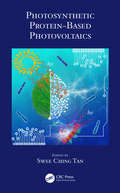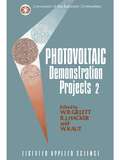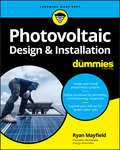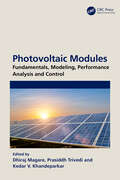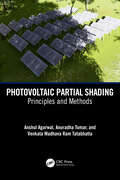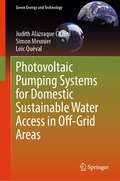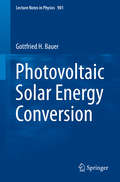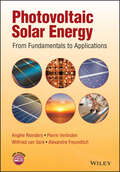- Table View
- List View
Photons and Quantum Fluctuations
by E R Pike; H Walther I Abram M Le Berre C Fabre E Giacobino F Haake A Heidmann C K Hong R Horowicz R Loudon L Mandel G L Mander Z Y Ou E R Pike J G Rarity S Reynaud Sarben Sarkar T J Shepherd P R Tapster H Walther M Wilkens H P YuenBased on a special ONR seminar, Photons and Quantum Fluctuations draws together discoveries in nonclassical or "silent" light for research workers and postgraduates in quantum optics. With nonclassical light, noise is reduced in amplitude below that expected by previous applications of the uncertainty principles. Historians of science who wish to ponder the philosophical implications of these developments may also find this a useful volume.
Photophysics of Carbon Nanotubes Interfaced with Organic and Inorganic Materials
by Victor A. Karachevtsev William B. Euler Igor A. LevitskyPhotophysics of Carbon Nanotubes Interfaced with Organic and Inorganic Materials describes physical, optical and spectroscopic properties of the emerging class of nanocomposites formed from carbon nanotubes (CNTs) interfacing with organic and inorganic materials. The three main chapters detail novel trends in photophysics related to the interaction of light with various carbon nanotube composites from relatively simple CNT/small molecule assemblies to complex hybrids such as CNT/Si and CNT/DNA nanostructures. The latest experimental results are followed up with detailed discussions and scientific and technological perspectives to provide a through coverage of major topics including: -Light harvesting, energy conversion, photoinduced charge separation and transport in CNT based nanohybrids -CNT/polymer composites exhibiting photoactuation; and -Optical spectroscopy and structure of CNT/DNA complexes. Including original data and a short review of recent research, Photophysics of Carbon Nanotubes Interfaced with Organic and Inorganic Materials makes this emerging field of photophysics and its applications available to academics and professionals working with carbon nanotube composites in fundamental and applied fields
Photophysics of Organometallics
by Alistair J. LeesArvind Kumar, Shih-Sheng Sun, and Alistair J. Lees: Photophysics and Photochemistry of Organometallic Rhenium Diimine Complexes; Conor Long: Photophysics of CO Loss from Simple Metal Carbonyl Complexes; Antonín Vlcek Jr: Ultrafast Excited-State Processes in Re(I) Carbonyl-Diimine Complexes: From Excitation to Photochemistry; Kenneth Kam-Wing Lo: Exploitation of Luminescent Organometallic Rhenium(I) and Iridium(III) Complexes in Biological Studies; Maria L. Muro , Aaron A. Rachford , Xianghuai Wang, and Felix N. Castellano: Platinum II Acetylide Photophysics; Andreas F. Rausch, Herbert H. H. Homeier, and Hartmut Yersin: Organometallic Pt(II) and Ir(III) Triplet Emitters for OLED Applications and the Role of Spin-Orbit Coupling: A Study Based on High-Resolution Optical Spectroscopy.
Photopolymers: Photoresist Materials, Processes, and Applications (Optics and Photonics)
by Kenichiro NakamuraAdvancements in photopolymers have led to groundbreaking achievements in the electronics, print, optical engineering, and medical fields. At present, photopolymers have myriad applications in semiconductor device manufacturing, printed circuit boards (PCBs), ultraviolet (UV) curing, printing plates, 3-D printing, microelectromechanical systems (MEMS), and medical materials. Processes such as photopolymerization, photodegradation, and photocrosslinking, as well as lithography technology in which photofabrications are performed by images of photopolymers, have given rise to very large-scale integrated (VLSI) circuits, microproducts, and more. Addressing topics such as chemically amplified resists, immersion lithography, extreme ultraviolet (EUV) lithography, and nanoimprinting, Photopolymers: Photoresist Materials, Processes, and Applications covers photopolymers from core concepts to industrial applications, providing the chemical formulae and structures of the materials discussed as well as practical case studies from some of the world’s largest corporations. Offering a state-of-the-art review of progress in the development of photopolymers, this book provides valuable insight into current and future opportunities for photopolymer use.
Photoptics 2014
by Paulo A. Ribeiro Maria RaposoThis collection of the selected papers presented to the Second International Conference on Photonics, Optics and laser technology PHOTOPTICS 2014 covers the three main conference scientific areas of "Optics", "Photonics" and "Lasers". The selected papers, in two classes full and short, result from a double blind review carried out by conference Program Committee members who are highly qualified experts in the conference topic areas.
Photoptics 2015
by Maria Raposo Paulo RibeiroThe book provides a collection of selected papers presented to the third International Conference on Photonics, Optics and Laser Technology PHOTOPTICS 2015, covering the three main conference scientific areas of "Optics", "Photonics" and "Lasers". The selected papers, in two classes full and short, result from a double blind review carried out by the conference program committee members which are highly qualified experts in conference topic areas.
Photorefractive Materials for Dynamic Optical Recording: Fundamentals, Characterization, and Technology
by Jaime FrejlichA comprehensive and up-to-date reference on holographic recording Photorefractive Materials for Dynamic Optical Recording offers a comprehensive overview of the physics, technology, and characterization of photorefractive materials that are used for optical recording. The author, a noted expert on the topic, offers an exploration of both transient and permanent holographic information storage methods. The text is written in clear terms with coherent explanations of the different methods that allows for easy access to the most appropriate method for a specific need. The book provides an analysis of the fundamental properties of the materials and explores the dynamic recording of a spatial electric charge distribution and the associated spatial electric field distribution. The text also includes information on the characterization of photorefractive materials using holographic and nonholographic optical methods and electrical techniques, reporting a large number of actual experimental results on a variety of materials. This important resource: Offers an in-depth source of information on the physics and technology of all relevant holographic recording methods Contains text written by a pioneer in the field—Jaime Frejlich's research defined the field of dynamic holographic recording Presents a one-stop resource that covers all phenomena and methods Includes a review of the practical applications of the technology Written for materials scientists, solid state physicists, optical physicists, physicists in industry, and engineering scientists, Photorefractive Materials for Dynamic Optical Recording offers a comprehensive resource on the topic from the groundbreaking expert in the field.
Photorefractive Optoelectronic Tweezers and Their Applications
by Michael EsselingIn the never-ending quest for miniaturization, optically controlled particle trapping has opened up new possibilities for handling microscopic matter non-invasively. This thesis presents the application of photorefractive crystals as active substrate materials for optoelectronic tweezers. In these tweezers, flexible optical patterns are transformed into electrical forces by a photoconductive material, making it possible to handle matter with very high forces and high throughput. Potential substrate materials' properties are investigated and ways to tune their figures-of-merit are demonstrated. A large part of the thesis is devoted to potential applications in the field of optofluidics, where photorefractive optoelectronic tweezers are used to trap, sort and guide droplets or particles in microfluidic channels, or to shape liquid polymers into optical elements prior to their solidification. Furthermore, a new surface discharge model is employed to discuss the experimental conditions needed for photorefractive optoelectronic tweezers.
Photorefractive Organic Materials and Applications
by Pierre-Alexandre BlancheThis book provides comprehensive, state-of-the art coverage of photorefractive organic compounds, a class of material with the ability to change their index of refraction upon illumination. The change is both dynamic and reversible. Dynamic because no external processing is required for the index modulation to be revealed, and reversible because the index change can be modified or suppressed by altering the illumination pattern. These properties make photorefractive materials very attractive candidates for many applications such as image restoration, correlation, beam conjugation, non-destructive testing, data storage, imaging through scattering media, holographic imaging and display. The field of photorefractive organic material is also closely related to organic photovoltaic and light emitting diode (OLED), which makes new discoveries in one field applicable to others.
Photoresist Technology in Microsystems: Principles, Processes and Applications (Springer Series in Advanced Microelectronics #15)
by Kaiying WangThis book presents a comprehensive overview of recent advances in photoresist technology, a cornerstone of modern microfabrication. Photoresists enable the precise patterning essential for creating microelectronic devices, MEMS, biomedical systems, and photonic components. As the demand for smaller, faster, and more efficient microsystems grows, the role of photoresists in achieving high-resolution patterning and complex 3D structures has become increasingly critical. However, despite its importance, there is a lack of comprehensive resources that bridge the gap between the fundamental principles of photoresist chemistry, advanced fabrication techniques, and their diverse applications. This book addresses this gap by providing a unified and up to-date exploration of photoresist technology, making it a timely and essential contribution to the field. The book balances theoretical depth with practical insights, making it accessible to readers with varying levels of expertise. The book is designed to cater to a broad audience, from students and researchers to industry professionals. A unique feature of this book is its emphasis on the interplay between material properties, processing techniques, and application-specific requirements.
Photosensitive Glass and Glass-Ceramics
by Nicholas F. BorrelliThis book will discuss how glass and glass ceramic interact with light, both transiently and permanently. Ways that light permanently alter the properties of glass and glass ceramic like the color, refractive index, and mechanical and chemical behaviors will be included. Each photochromatic phenomenon will be discussed in detail from the physical and chemical origin to the method fabrication and ultimately to their utilization.
Photosensitive Polyimides: Fundamentals and Applications
by Takashi YamashitaThis is the first book to provide an in-depth presentation of photosensitive polyimides for electronic and photonic applications. The authors are leading specialists in this field from Japan, Europe and the U.S.From the PrefaceAromatic polyimides were developed originally as thermostable flexible polymer films for space applications. Now polyimides have found widespread use in the manufacture of electronic devices and have been employed in increasingly diverse areas of electronics and information technology. In addition to their excellent thermal stability and high processability, a wide range of chemical and physical properties provided by molecular engineering makes polyimides highly versatile in the electronics and information industries.Lithography of polyimides is an inevitable process in using polyimides for microelectronic fields, and hence increasing research has been devoted to developing photosensitive polyimides, which make it unnecessary to use photoresists for patterning polyimides and diminishing markedly the number of steps in fabrication of various electronic devices.In addition, the development of technology of photosensitive polyimides is expected to play a great role in manufacturing photonic devices in the near future, when the design and control of hyper fine structures . . . including higher thermal stability and better processability would be essential.
Photosynergetic Responses in Molecules and Molecular Aggregates
by Hiroshi Miyasaka Kenji Matsuda Jiro Abe Tsuyoshi KawaiThis book compiles the accomplishments of the recent research project on photochemistry “Photosynergetics”, supported by the Ministry of Education, Culture, Sports, Science and Technology of Japan, aiming to develop and elucidate new methods and molecules leading to advanced utilization of photo-energies. Topics include photochemical responses induced by multiple excitation, multiphoton absorption, strong modulation of electronic states, developments of new photofunctional molecules, mesoscopic actuations induced by photoexcitation, and novel photoresponses in molecules and molecular assemblies. The authors stress that these approaches based on the synergetic interaction among many photons and many molecules enable the expansion of the accessibility to specific electronic states. As well, they explain how the development of reaction sequences and molecules/molecular assemblies ensure “additivity” and “integration” without loss of the photon energy, leading to new photoresponsive assemblies in meso- and macroscopic scales.
Photosynthesis-Assisted Energy Generation: From Fundamentals to Lab Scale and In-Field Applications
by Sathish-Kumar Kamaraj Iryna RusynPhotosynthesis-Assisted Energy Generation Describes the mechanisms of and potential for using microorganisms and plants as renewable power resources Bridging the knowledge gap between the fundamentals and the technological advances in biological photosynthesis-assisted energy generation, Photosynthesis-Assisted Energy Generation explores the various diverse light-harvesting biological systems for electricity generation and explains the fundamentals and applications from lab-scale to in-field. The text discusses the fundamentals of electron transfer mechanisms in photosynthetic systems, basic principles of bioelectricity generation, and materials involved in the construction of fuel cells, including not only the impact of higher plants, but also anoxygenic and oxygenic photosynthetic bacteria and microalgae on the performance of photosynthesis-assisted power generation systems. A timely resource, the text features case studies on emerging topics such as mosses in power generation on green roofs and photo-bioelectrochemical fuel cells for antibiotics and dyes removal, along with discussion of sustainability issues when scaling up bio-photo-electrochemical systems. Edited by two highly qualified and accomplished academics with significant research experience in the field, Photosynthesis-Assisted Energy Generation includes information on: Role of functional materials involved in photosynthesis-assisted power generation and non-noble electrocatalysts as air cathodes in biocells Electricity generation and intensified synthesis of nutrients by plant-based biofuel cells using duckweeds as biocatalysts Algae-based microbial fuel cells, photosynthetic bacteria-based microbial fuel cells, and bryophyte microbial fuel cell systems Progress and recent trends of application of low-energy consuming devices and IoT based on photosynthesis-assisted power generation Plant-based microbial fuel cells for bioremediation, biosensing, and plant health monitoring With full coverage of an attractive renewable energy generation system, Photosynthesis-Assisted Energy Generation is an essential resource on the subject for researchers and scientists interested in alternative renewable energetics and photosynthesis-assisted energy generation processes utilizing microorganisms, algae, plants, and other bioinspired materials.
Photosynthesis: Molecular Approaches to Solar Energy Conversion (Advances in Photosynthesis and Respiration #47)
by Suleyman I. Allakhverdiev Kimiyuki Satoh Jian-Ren ShenIn the modern world, to meet increasing energy demands we need to develop new technologies allowing us to use eco-friendly carbon-neutral energy sources. Solar energy as the most promising renewable source could be the way to solve that problem, but it is variable depending on day time and season. From this side, the understanding of photosynthesis process could be of significant help for us to develop effective strategies of solar energy capturing, conversion, and storage. Plants, algae, and cyanobacteria perform photosynthesis, annually producing around 100 billion tons of dry biomass. Presently, the detailed studies of photosynthetic system structure make functional investigations of the photosynthetic process available, allowing scientists to construct artificial systems for solar energy transduction. This book summarizes exciting achievements in understanding of photosynthetic structures and mechanisms of this process made by world leaders in photosynthesis field, and contains information about modern ideas in development of revolutionary new technologies of energy conversion. Organized according to the natural sequence of events occurring during photosynthesis, the book includes information of both photosynthetic structures and mechanisms and its applications in bioenergetics issues.
Photosynthetic Protein-Based Photovoltaics
by Swee Ching TanEver since the discovery of the photoelectric effect, researchers have been trying to improve the efficiency of converting sunlight into electricity through photovoltaic devices. Photosynthetic organisms provide clues for harvesting sunlight and storing the energy in chemical forms. This book offers a concise overview of the fundamental concepts of photosynthesis and the emerging photovoltaic technologies, casting light on the symbiotic relation between these spheres of science. Although there are many books about the fundamentals of photosynthesis and the various aspects of the photosynthetic processes, this is the first volume to focus on the prospects of studying the photosynthetic proteins, understanding and applying their properties to design prospective solar energy conversion devices that are sustainable and efficient. All in all, the book aims to bring together the present know-how on organic photovoltaics and dye-sensitized solar cells with that of the emerging bio-photovoltaics and the underlying physics of photosynthesis to foster a more eclectic research that would converge towards a sustainable energy technology for the future. The book mainly serves as a bridge to connect biochemists, who study photosynthetic proteins, and physicists and engineers who design and develop photovoltaic devices. Scientists, engineers and students in the fields of photosynthetic research and solar energy research can use this book as a ready reference. Key selling features: Covers both methods and bio-based materials needed to build bio-based photovoltaics Focuses on both techniques and applications Summarizes the advantages and limitations of various techniques Contributors from multiple disciplines integrate the knowledge of photosynthetic proteins and the physics/engineering of photovoltaic devices. Includes adaptive designs and techniques used in other types of solar cells to for the design of protein-based PVs
Photovoltaic Demonstration Projects 2
by W. B. Gillett R. J. Hacker W. KautProceedings of the Third Contractors' Meeting, Joint Research Centre, Ispara, Italy, 18-20 May 1988.
Photovoltaic Design & Installation For Dummies
by Ryan MayfieldPhotovoltaic Design and Installation For Dummies (9781119544357) was previously published as Photovoltaic Design and Installation For Dummies (9780470598931). While this version features a new Dummies cover and design, the content is the same as the prior release and should not be considered a new or updated product. The fun and easy way to get a grip on photovoltaic design and installation Designing and installing solar panel systems is a trend that continues to grow. With 'green collar' jobs on the rise and homeowners looking for earth-friendly ways to stretch their dollars and lesson their carbon imprint, understanding photovoltaic design and installation is on the rise. Photovoltaic Design & Installation For Dummies gives you a comprehensive overview of the history, physics, design, installation, and operation of home-scale solar-panel systems. You'll also get an introduction to the foundational mathematic and electrical concepts you need to understand and work with photovoltaic systems. Covers all aspects of home-scale solar-power systems Viable resource for professionals, students, and technical laymen Can be used to study for the NABCEP exam Whether you're a building professional looking to expand your business and skills to meet the growing demand for solar power installation or are seeking a career in this rapidly expanding field, Photovoltaic Design & Installation For Dummies has you covered!
Photovoltaic Design and Installation For Dummies
by Ryan MayfieldThe fun and easy way to get a grip on photovoltaic design and installationDesigning and installing solar panel systems is a trend that continues to grow. With 'green collar' jobs on the rise and homeowners looking for earth-friendly ways to stretch their dollars and lesson their carbon imprint, understanding photovoltaic design and installation is on the rise.Photovoltaic Design & Installation For Dummies gives you a comprehensive overview of the history, physics, design, installation, and operation of home-scale solar-panel systems. You'll also get an introduction to the foundational mathematic and electrical concepts you need to understand and work with photovoltaic systems.Covers all aspects of home-scale solar-power systemsViable resource for professionals, students, and technical laymenCan be used to study for the NABCEP examWhether you're a building professional looking to expand your business and skills to meet the growing demand for solar power installation or are seeking a career in this rapidly expanding field, Photovoltaic Design & Installation For Dummies has you covered!
Photovoltaic Laboratory: Safety, Code-Compliance, and Commercial Off-the-Shelf Equipment
by Peter T. ParrishPhotovoltaic Laboratory: Safety, Code-Compliance, and Commercial Off-the-Shelf Equipment is the only textbook that offers students the opportunity to design, build, test, and troubleshoot practical PV systems based on commercially available equipment. Complete with electrical schematics, layouts, and step-by-step installation instructions, this hands-on laboratory manual: Promotes "safety first" by covering working in extreme weather conditions, personal protective equipment, working at heights, electrical safety, and power tool safety Includes chapters on trade math, DC/AC electrical circuits, and assessing a property for a photovoltaic system (e.g., surveying the available space, shading, and solar harvest) Discusses aspects of mechanical and electric integration specific to different roof types, and characterizing a PV module under different levels of irradiation and ambient temperature Addresses the design, installation, and testing of off-grid PV systems with DC-only loads and with DC and AC loads, as well as 2.4 kw DC grid-tied PV systems with microinverters and string inverters Trains students on exactly the sort of equipment that they will encounter in the field, so they gain valuable experience and skills that translate directly to real-world applications Photovoltaic Laboratory: Safety, Code-Compliance, and Commercial Off-the-Shelf provides in-depth, project-driven instruction on everything from attaching brackets and flashing to modeling PV cells, modules, and arrays. This textbook is ideal preparation for those seeking a career in the PV industry—from system installers and designers to quality assurance and sales/marketing personnel.
Photovoltaic Modules: Fundamentals, Modeling, Performance Analysis and Control
by Dhiraj Magare, Prasiddh Trivedi and Kedar V. KhandeparkarThe book provides a comprehensive review of developments in all aspects of solar photovoltaic technology in a single volume. It discusses maximum power point tracking (MPPT) control for achieving maximum possible power, robust control to maintain stable operation under varying internal as well as the ambient environment, inverter control for constant frequency operation, and automating the maintenance of photovoltaic solar plants. This book: Presents modeling methods based on mathematical and physical principles for solar photovoltaic cells, power quality analysis of rooftop grid-connected PV, and PV generation analyzed by bidirectional long short-term memory networks (BiLSTM) to evaluate the performance reliability of the bifacial module and the control system of the synchronous reference CCVSI for active power injection Provides an overview of SPECS control, various control loops, control algorithms, controllers, and their impact on the prosumer and the smart grid and discusses instantaneous power theory (pq theory) Covers control techniques of power electronic converters, optimization techniques, and management of the grid-connected solar PV arrays, qualification testing of bifacial modules as per IEC- 61215: 2021 and IEC 61730, including analytical approach elaborated for the performance of a building-integrated solar PV/T system Discusses and comprehensively reviews degradation mechanisms, characterization techniques, and occurrence frequencies based on field testing, long-term analyses of PV installations, harmonic compensation, and the enhancement of Power Quality for the entire system, a novel approach of developing an effective and systematic brownout procedure and a novel game theory auctioning framework for trading energy in smart grids and explains Gbest-guided Artificial Bee Colony (GABC) optimization Includes real-life case studies It will serve as an ideal reference text for senior undergraduate, graduate students, and academic researchers in fields including electrical engineering, electronics and communications engineering, environmental engineering, and renewable energy.
Photovoltaic Partial Shading: Principles and Methods
by Anuradha Tomar Anshul Agarwal Venkata Madhava TatabhatlaThis text comprehensively discusses the modeling of photovoltaic (PV) modules, PV array interconnections, multi-level inverters, distributed maximum power point tracking techniques, and static and dynamic PV array reconfiguration techniques. It gives a step-by-step procedure for hardware validation of the partial shading mitigation techniques.This book: Focuses on the impacts and mitigation techniques related to partial shading problems associated with PV systems. Presents a step-by-step guide for addressing partial shading problems in PV systems. Covers methods like array reconfiguration through Tom-Tom puzzle pattern and Arrow Sudoku pattern. Presents hardware validation of the partial shading mitigation techniques. Elaborates static and moving shading conditions in a detailed manner. It will serve as an ideal reference text for graduate students and academic researchers in the fields of electrical engineering, electronics and communication engineering, environmental engineering, and renewable energy.
Photovoltaic Pumping Systems for Domestic Sustainable Water Access in Off-Grid Areas (Green Energy and Technology)
by Judith Alazraque Cherni Simon Meunier Loïc QuévalThis book offers practical guidance for practitioner engineers, policymakers, and other decision-makers on how to implement solar photovoltaic water pumping systems to provide domestic clean water in off-grid regions of developing countries. By championing genuine multidisciplinary research and generating interdisciplinary results, this book develops models and approaches which indicate how it might be possible to overcome some of the limitations that technocratic approaches to renewable energy and water access pose to truly sustainable development.The book addresses technical challenges often found when promoting photovoltaic water pumping systems. It offers practical guidance to stakeholders on how to successfully select, install, and maintain photovoltaic water pumps to promote sustainable options for the poorest underserved areas/populations. A main novelty of this book is that, by using theoretical, as well as real/actual field-work data, and advanced modelling, it successfully connects energy systems engineering, environmental and geographical information and hydrology with population surveys which reveal local needs and conditions.The book is timely and important. More than 665 700 million worldwide still do not have access to improved drinking water sources; eight out of ten live in rural areas typically located either in off-grid territory, or where connection to nearby grid is too expensive or unfeasible. Unsafe water is responsible for 1.2 million deaths each year, mainly correlated with the diarrheal diseases generated from drinking water from unimproved water sources. Sustainable Development Goal 6 (clean water and sanitation) may be achieved only if water is accessible to everyone, available when needed and free from contamination.
Photovoltaic Solar Energy Conversion
by Gottfried H. BauerThis concise primer on photovoltaic solar energy conversion invites readers to reflect on the conversion of solar light into energy at the most fundamental level and encourages newcomers to the field to help find meaningful answers on how photovoltaic solar energy conversion can work (better), eventually contributing to its ongoing advancement. The book is based on lectures given to graduate students in the Physics Department at the University of Oldenburg over the last two decades, yet also provides an easy-to-follow introduction for doctoral and postdoctoral students from related disciplines such as the materials sciences and electrical engineering. Inspired by classic textbooks in the field, it reflects the author's own ideas on how to understand, visualize and eventually teach the microscopic physical mechanisms and effects, while keeping the text as concise as possible so as to introduce interested readers to the field and balancing essential knowledge with open questions.
Photovoltaic Solar Energy: From Fundamentals to Applications
by Alexandre Freundlich Angèle Reinders Pierre Verlinden Wilfried Van SarkSolar PV is now the third most important renewable energy source, after hydro and wind power, in terms of global installed capacity. Bringing together the expertise of international PV specialists Photovoltaic Solar Energy: From Fundamentals to Applications provides a comprehensive and up-to-date account of existing PV technologies in conjunction with an assessment of technological developments. Key features: Written by leading specialists active in concurrent developments in material sciences, solar cell research and application-driven R&D. Provides a basic knowledge base in light, photons and solar irradiance and basic functional principles of PV. Covers characterization techniques, economics and applications of PV such as silicon, thin-film and hybrid solar cells. Presents a compendium of PV technologies including: crystalline silicon technologies; chalcogenide thin film solar cells; thin-film silicon based PV technologies; organic PV and III-Vs; PV concentrator technologies; space technologies and economics, life-cycle and user aspects of PV technologies. Each chapter presents basic principles and formulas as well as major technological developments in a contemporary context with a look at future developments in this rapidly changing field of science and engineering. Ideal for industrial engineers and scientists beginning careers in PV as well as graduate students undertaking PV research and high-level undergraduate students.

